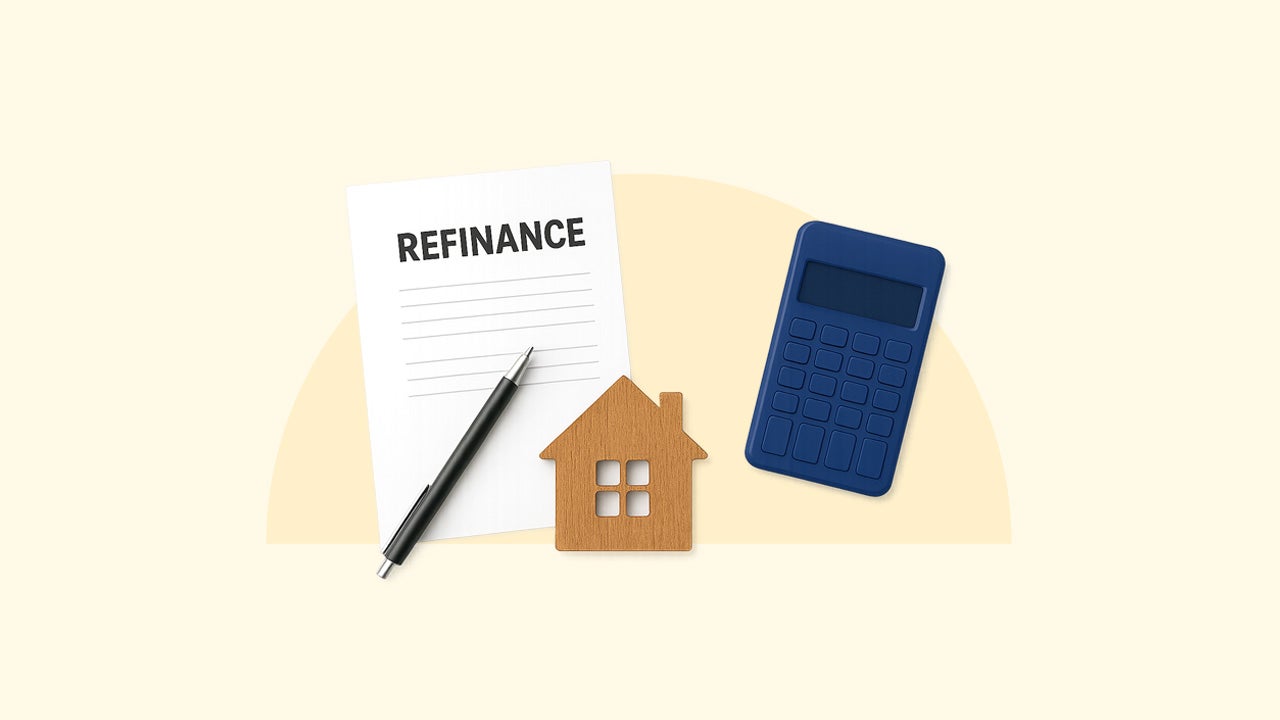Key takeaways
- It’s best to refinance a personal loan if you can lower your rate and save money without extending your repayment term.
- Refinancing your personal loan could give you double-digit APR savings if your credit tier has improved (from bad to fair, fair to good, etc.).
- Compare rates, fees and terms from multiple lenders or on a marketplace site like Bankrate to get the best deal when shopping for a new personal loan.
- Refinancing may not make sense if you’re almost finished repaying your loan or don’t have a stable income.
Personal loans have the widest annual percentage rate (APR) ranges of just about any loan product — as low as 5.99 percent for excellent credit to nearly 36 percent for bad credit. Refinancing a personal loan by replacing it with a new loan could lower your rate and payment in a big way — especially if you took out your first loan when you had bad credit.
For example, your personal loan rate could drop from 26.8 percent to 17.9 percent if your score has improved from bad to good — nearly 10 percentage points, based on TransUnion data. You can also choose to extend your repayment term to lower your payment, but you could end up paying more total interest.
Ultimately, the right decision depends on your credit score, finances and income stability. It’s also important to consider your overall financial goals before you refinance to determine if a personal loan refinance helps or hinders them.
How to refinance a personal loan
When you refinance a personal loan, you should know the terms of your current loan, the payoff balance and your credit score before prequalifying with lenders. You’ll follow the same initial steps to refinance a personal loan as you do when getting a personal loan for any purpose.
However, you’ll need to take a few extra steps to determine if refinancing makes financial sense for you.
1. Find out what your payoff balance is
To ensure that you don’t borrow more than you need, ask your current lender for a payoff balance. Many lenders provide this information online, so check there first. Although it’s rare, make sure your loan doesn’t have a prepayment penalty. If it does, you may want to skip refinancing until the prepayment penalty period has passed.
2. Check your credit score and credit report
This is the most critical step when refinancing a personal loan. Even a few extra points up or down could have a major impact on the refinance terms you’re offered. Here’s how TransUnion breaks down the credit scoring tiers:
| Credit tier | Score range | Median APR (TransUnion Q4 2024 data) |
| Superb | 780+ | 10.9% |
| Excellent | 721-780 | 13.2% |
| Good | 661-720 | 17.9% |
| Fair | 601-660 | 26.8% |
| Bad | 300-600 | No data |
How it works in real life:
Let’s say that Mary has a current credit score of 710. That puts her in the good credit tier, but if she can boost her score above 720, she’ll be in the excellent credit category. That could mean a lower rate, more repayment term options and potentially lower fees.
Quick credit score boost tip
Paying down credit card balances often produces the fastest credit score improvement results. If you have a few small maxed-out cards, paying them off could put you over the threshold for a better personal loan refinance rate
You can request free weekly copies of your credit reports from each of the three credit bureaus — Equifax, Experian and TransUnion. Your bank or credit card issuer may give you free access to your credit score, or you can buy it from one of the credit bureaus.
3. Compare rates and terms
It’s important to compare at least three different lender offers when you’re considering a personal loan refinance. Try credit unions, banks or online lenders to see what they offer based on your credit scores, loan amount and loan term. If that’s too overwhelming, check personal loan rates on a marketplace site like Bankrate.
Some lenders specialize in bad credit loans, while others may reward excellent credit borrowers with the lowest rates. Check each lender’s minimum score requirements, and keep an eye out for income minimums (especially at excellent credit lenders).
Keep an eye on origination fees, which can increase your APR.
If you’re looking to lower your monthly payments, consider a longer term, such as six or seven years, instead of three or five years. Just make sure you use a personal loan calculator to see how much total interest you’ll pay for the extra years it will take to pay off the loan in full.
Consumers hate fees. So, why do many personal loans still charge for origination?
Bankrate asked lenders about why they do (or don’t) charge origination fees. We also got great tips about how to avoid them entirely.
Read on
How it works in real life
Jack took out a personal loan a year ago to get his credit card debt under control. He was drowning in about $15,000 worth of maxed-out cards and had a bad credit rate of 25 percent. He still owed about $13,000, but his credit score had improved to fit into the “good” credit range, with average rates of around 13 percent.
He had four years left on his five-year loan and was considering refinancing to a new five-year loan, hoping the extra APR savings would offset the extra year he’d be adding on to his term. While shopping around, he got three prequalified offers.
- $13,000 loan amount at 14.5 percent with no origination fees on a 5-year term.
- $13,000 loan amount with 8 percent origination fees and a 12 percent rate.
- $13,000 loan amount with a seven-year term at 15 percent and no fees.
| Loan terms | Current loan | Option 1 | Option 2 | Option 3 |
| Monthly payment | $440 | $306 | $289 | $251 |
| Total interest | $11,416.19 | $5,352.06 | $4.350.67 | $8,072.06 |
| Fees | N/A | $0 | $1,040 | $0 |
What Jack needs to decide:
- Option #1 is a good option if Jack wants his loan paid off in five years with no origination fees.
- Option #2 has the lowest total interest, but won’t give Jack enough to pay the entire loan balance off, since $1,040 will be deducted for fees. He either has to borrow more money to cover the fees, or pay the payoff balance out of pocket.
- Option #3 gives Jack the lowest payment, but costs the most interest of the three refinance options. It make sense if Jack wants the almost $190/month payment savings.
Take action
Make sure you get offers from lenders who allow you to prequalify so you don’t ding your credit while you’re shopping. To understand the overall costs of each loan, try using a personal loan calculator.
4. Speak with your current lender
If you’ve made your payments on time, it may be worth it to request a second personal loan off the strength of your existing relationship. Lenders may offer to waive fees or give you some other perk like free credit monitoring if you refinance your loan with them.
If your current lender’s terms don’t look good at first, ask them if they’d be willing to match a competitor’s offer. Some lenders offer price match guarantees that could land you a better rate — if you ask.
Can I refinance my personal loan with the same lender?
You may be able to refinance with the lender that currently holds your loan, but not every lender allows this. Even if your current lender permits refinancing, it’s worth comparing loan offers from other lenders as well, since you may qualify for better terms elsewhere.
5. Apply for the loan
Prequalification gets you started, but an application will get you to the finish line. The full application process is when the lender validates the information you provided on your application, and pulls your credit to finalize your terms.
Gather any information and documents the lender will need to make a decision. Most lenders request the following:
- A copy of your driver’s license, state-issued ID or passport
- Proof of address, like a mortgage statement, rental agreement, utility bill, auto insurance bill or bank statement
- Your Social Security number
- Paystubs, W2 forms or tax returns
- Bank statements, 1099s or tax returns (if self-employed)
- Your employer’s contact information
- Access to your bank account to direct deposit the loan funds.
Take action
Read through the fine print of the loan before accepting it. Take note of your payment schedule and any fees, including prepayment penalties. If you’re satisfied with the terms of the loan, you can sign the loan contract. You’ll typically receive funds within a few days, though some lenders offer same-day funding.
6. Start making payments on your new loan
Once you receive the funds from your new loan, use them to pay off your existing loan. This should be done as soon as possible to avoid accruing unnecessary interest or making double loan payments. Always continue to make the payments on your current loan until you confirm it is paid in full.
It’s easier to get a refund of money you overpaid than for your credit score to recover from a late payment.
Take action
Set up autopay for your new refinance loan so you never miss a payment.
Pros and cons of refinancing a personal loan
Pros
- Potentially lower interest rate
- Faster loan payoff
- Extended repayment period
- Lower potential payment
- Lower total interest paid over life of loan
Cons
- Origination fees high at some lenders
- Prepayment penalties (rare but possible)
- Potentially higher interest costs if extending repayment term
- Credit score impacts from inquiries
- Research and application time
How refinancing a personal loan affects your credit score
When you finalize your refinance application, you’ll be subject to a credit check. This can temporarily lower your credit score slightly. Although your score usually recovers quickly, even a small hit could hurt if you’re also looking to buy a car or move into a new apartment. Car dealers and landlords check your credit score, and refinancing your loan at the wrong time could make it more difficult to find a vehicle or housing.
Should you refinance your personal loan?
You should refinance a personal loan if it provides a definite benefit to your current finances or moves you toward a future goal.
When to refinance a personal loan
- After a major credit score improvement. You could see a large drop in your personal loan rate if your score has improved significantly.
- You need a lower payment. If your hours have been cut back, or your spouse’s income recently dropped, it may make sense to refinance to a longer term so you can afford your payment.
- You’d like to pay your loan off faster. One major benefit of refinancing to a shorter term is to pay the least amount of interest. Just remember, the shorter your term, the higher your monthly payment will be.
- You’ll break even on the fees. Some lenders charge origination fees, which can make borrowing more expensive. Calculate how long it will take to recoup your fees. For example, if you pay $1,000 in fees and your monthly payment savings is $100, it will take you 10 months to recoup the costs of the refinancing.
When you should avoid refinancing a personal loan
- You just lost your job. Personal loans require proof of stable earnings, since you’ll be repaying the loan with a fixed payment for several years. If you were laid off or quit, you aren’t likely to be approved for a new personal loan.
- Your loan balance is low. If you don’t owe much on your existing loan, it may not make financial sense to refinance. Instead of incurring more fees, work on paying off the balance on your original loan more quickly.
- You’re caught in a serial debt consolidation cycle. If you find you’re constantly refinancing personal loans that you continue to take out to pay off credit cards, it may be time to talk to a credit counselor before you refinance another personal loan.
- Your loan term is almost finished. If you’re within a year of paying off your loan, avoid refinancing unless you’re at risk of making a late payment because of a sudden loss of income or large unexpected expense.
Bottom line
Before you refinance a personal loan, take a look at the average rate you could get based on your credit scores. If you’re holding out for lower rates from a Fed rate cut, you may be waiting awhile. Stubborn inflation combined with economic uncertainty has kept the Federal Reserve’s rate-cutting plans at bay. But if your credit score has improved since you initially took out the loan, you may be positioned to save.
Why we ask for feedback
Your feedback helps us improve our content and services. It takes less than a minute to
complete.
Your responses are anonymous and will only be used for improving our website.
Help us improve our content
Read the full article here
















